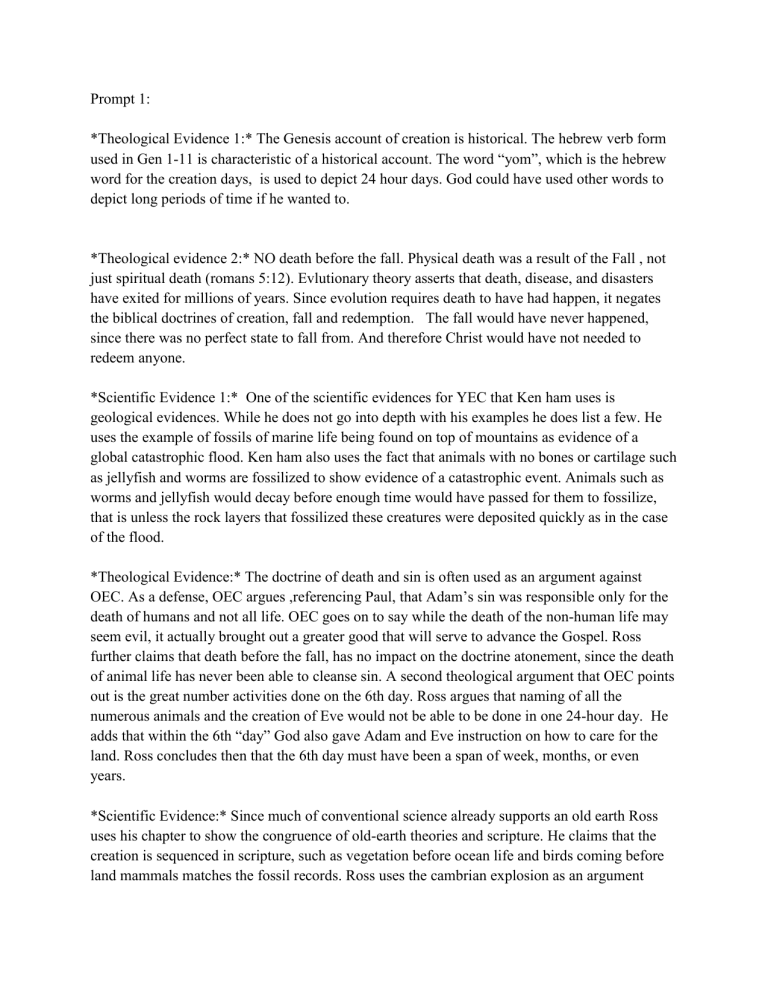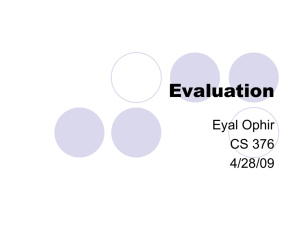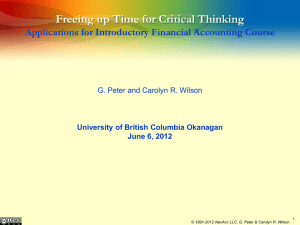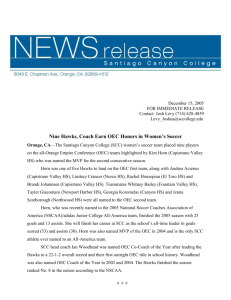Creation, Evolution, and Intelligent Design: A Comparative Analysis
advertisement

Prompt 1: *Theological Evidence 1:* The Genesis account of creation is historical. The hebrew verb form used in Gen 1-11 is characteristic of a historical account. The word “yom”, which is the hebrew word for the creation days, is used to depict 24 hour days. God could have used other words to depict long periods of time if he wanted to. *Theological evidence 2:* NO death before the fall. Physical death was a result of the Fall , not just spiritual death (romans 5:12). Evlutionary theory asserts that death, disease, and disasters have exited for millions of years. Since evolution requires death to have had happen, it negates the biblical doctrines of creation, fall and redemption. The fall would have never happened, since there was no perfect state to fall from. And therefore Christ would have not needed to redeem anyone. *Scientific Evidence 1:* One of the scientific evidences for YEC that Ken ham uses is geological evidences. While he does not go into depth with his examples he does list a few. He uses the example of fossils of marine life being found on top of mountains as evidence of a global catastrophic flood. Ken ham also uses the fact that animals with no bones or cartilage such as jellyfish and worms are fossilized to show evidence of a catastrophic event. Animals such as worms and jellyfish would decay before enough time would have passed for them to fossilize, that is unless the rock layers that fossilized these creatures were deposited quickly as in the case of the flood. *Theological Evidence:* The doctrine of death and sin is often used as an argument against OEC. As a defense, OEC argues ,referencing Paul, that Adam’s sin was responsible only for the death of humans and not all life. OEC goes on to say while the death of the non-human life may seem evil, it actually brought out a greater good that will serve to advance the Gospel. Ross further claims that death before the fall, has no impact on the doctrine atonement, since the death of animal life has never been able to cleanse sin. A second theological argument that OEC points out is the great number activities done on the 6th day. Ross argues that naming of all the numerous animals and the creation of Eve would not be able to be done in one 24-hour day. He adds that within the 6th “day” God also gave Adam and Eve instruction on how to care for the land. Ross concludes then that the 6th day must have been a span of week, months, or even years. *Scientific Evidence:* Since much of conventional science already supports an old earth Ross uses his chapter to show the congruence of old-earth theories and scripture. He claims that the creation is sequenced in scripture, such as vegetation before ocean life and birds coming before land mammals matches the fossil records. Ross uses the cambrian explosion as an argument against evolution. He claims that such a rapid expansion of various creatures is the work of creator. He also mentions that in the pre-cambrian explosion life mainly consisted of microbes, but during the explosion large mammals appeared very quickly. Ross asserts that since there have been no natural mechanism to explain this rapid appearance of new life, that it had been done by God. *Scientific Evidence:* In order to support the old age of the earth, Haarsma pointed out to the glacial layers which depict snowfall of each year. She claims that these layers have been counted back over thousands of years. Haarsma adds to this point by bringing up the fact that astronomers are able to see galaxies billions of light years away. In order for us to see these galaxies, light must have traveled billions of years, and she therefore concludes that the universe must have existed at least that long. She also provides evidence for evolutionary theory. She give the fossil evidence for the evolution of whales as an example. She posits that there is fossil evidence of creatures that were once land mammals gradually adapting to marine life and eventually becoming the whales we see today. The connection between the whales and their ancestors seem to be the presence of similar inner ear structures of both creatures. *Thoeological/Philosophical Argument 1:* This is based on the philosophy of science concept of “causal adequacy” which is used to determine which theory is best when it comes to Intelligent Design is causally adequate. It makes sense that such complex information systems such as DNA was created. From experience specific information usually comes from an intelligent source. *Theological/Philosophical Argument 2:* ID is not an argument from ignorance. Many criticize ID for for using the lack of evidence for a material cause or mechanism as evidence that a higher intelligence must have been the cause. Meyers refutes that this is not the case, but rather that the evidence that is seen in nature is used as evidence that the most plausible cause of things such as life is intelligent design. Prompt 2: In his chapter, Ken Ham had little to say regarding evolution in a scientific sense, bur rather took the time to address it with a theological approach. His first address towards evolution regarded the use of the word “min”. He asserts that “min”was akin to the order of family. He implies that microevolution and the development of new species within a family is possible and evident. However, he does not agree that evolution can create new “kinds” or change one type of creature into another. Basically, his interpretation of the hebrew word “min” allows for microevolution but not macroevolution. YEC believes that the earth is young and that all the kinds (families) of creatures were created by God. Evolution is limited to microevolution. The Diversity of the families his caused by God alone. However the diversity of species within families can be explains via adaption or in other words microevolution. Since the OEC view espouses an earth being billions of years old, some critics may argue that that amount of time is enough to allow evolution to proceed, however, Ross disagrees with this proposition. Ross argues that while the earth spans billions of years, the natural process of evolution would not have been enough to sustain life, let alone create new species. Ross uses the evidence of the Sun’s luminosity to argue that it was God who created life and sustain the Earth. The argument follows that mass extinction and appearance of new species is in accordance with the Sun’s change in luminosity. The increase in the Sun’s luminosity would increase the temperature of the atmosphere. The new species that would appear would serve to keep Earth’s atmosphere viable for future life. Ross argues that the natural process of evolution would not have been able to produce such a quick answer to the change in temperature and that it was the result of God’s sustaining act. OEC, like most of the creation theories in the book, does believe in microevolution. Ross uses the case that the animals in Noahs flood have adapted of micro evolved into the numerous species we see today. Ross implies, that over a long period of time, microevolution accounts for the diversity of species we see today. OEC, however, does not believe that macro evolution could occur. He uses the MSU E.Coli experiment to show that the natural evolutionary process more often leads to extinction rather than speciation. Amongst the viewpoints in the book, EC is the strongest advocate for macroevolution and natural selection. However, it is not the naturalistic evolution that is espoused by most secular scientists. EC believes that God directs and guides evolution in order to fulfill his purposes. With evolution being directed by God this circumvents the problem of things like the improbability of life starting by natural means or other phenomenon like the cambrian explosion. EC believes that both macro and micro evolution can account for the diversity of that is present today. EC also believes in an old earth that would allow enough time for the process of evolution to occur Haarsma claims that there is genetic evidence that animals such as humans and chimpanzees have a common ancestor, and that natural selection the evolutionary process caused the offsprings of said ancestors to become different creatures entirely. Haarsma also uses fossil evidence to show the progressive evolution of not only humans but other animals, such as whales as well. Of course, Haarsma also affirms that animal still undergo macroevolution today, however there was nothing that addresses whether the same can be said for humans. Intelligent Design deals with evolution through interesting approach that can be seen as a detached ground of the three views. While Intelligent Design does not directly disavow evolution, ID does disagree with the idea of random, unguided, purely materialistic evolution. In its Chapter ID doesn’t even dress the evolution of new species directly but rather focuses on the sheer improbability for life to begin on its own. Meyers mentions the that given how improbable it would be for non-living chemicals to create an information rich system that life could not have began without intervention from an intelligent source. Meyers allows the reader to infer multiple things about biological evolution without actually addressing it himself. First, Meyers implies that if materialistic evolution were true that the 13.8 billion years that the universe has existed would be much insufficient to create the vast complex life we see today through means of random trial and error. 2nd, in light of the extent of biological evolution, Meyers implies that, given its complexity, biological evolution cannot continue past its current point without intelligent intervention. Meyer’s does not mention the specific mechanisms of evolution. Prompt 3 YEC holds that the genesis creation account is a literal and historical account. YEC interprets the Hebrew word “yom” to mean a literal 24-hour day and therefore interpret the creations days as such. YEC also views that God created supernaturally, that is he did not create and allow processes to finish his creations. Rather, God’s created with his creations being fully ready to fulfill his purpose. YEC believes that there was a flood of global and catastrophic proportions. Finally, YEC believes that the genealogies depicted in Genesis 5-11 that show a lineage from father to son are strict chronologies and that therefore Adam was created 2000 years before Abraham. In regards of the Fall, YEC believes that its doctrines are closely tied to creation and that to hold to the beliefs of OEC and EC would be damaging to the doctrine of the Fall. YEC asserts that a “fall” implies a transition from perfect to imperfect. EC contradicts this because evolution is a development from simple to complex or imperfect to more perfect. YEC also holds that death was a result of the Fall, and that having there be death before the creation of man , as believed in OEC and EC would negate the entire concept of the fall and death as the punishment for sin. The strengths found in the YEC lie mainly in its theological arguments. YEC is a position that allows for the least amount of accommodation in the Bible. YEC then takes the greatest precaution in ensuring that the Bible dictates how they interpret science and not the other way around. YEC’s weakness lies in its few scientific support. Ham mentions two challenges that YEC faces today: the stars that are millions of light years away and radiometric dating. As of now, these two things provide a huge scientific obstacle for YEC that severely weakens their argument. It is difficult to say whether OEC reads Genesis more literally than metaphorically since they interpret words in a different context. For example, OEC claims that there are multiple interpretations of the Hebrew word “yom”, and as such they choose to interpret it in the less common form that means “a period of time”. This interpretation goes further to claim the the 7th “day” is still ongoing. OEC also believes that the Flood was not global, since their interpretation of “world” refers to the human societies present at the time of the flood. OEC does believe God had created all living creatures and that Adam and Eve were historical figures and the parents of humanity. While OEC still believes in an actual Fall, they do not believe that having death before creation changes what the Bible says about the Fall. The doctrine of death and sin is often used as an argument against OEC. As a defense, OEC argues ,referencing Paul, that Adam’s sin was responsible only for the death of humans and not all life. OEC goes on to say while the death of the non-human life may seem evil, it actually brought out a greater good that will serve to advance the Gospel. Ross further claims that death before the fall, has no impact on the doctrine atonement, since the death of animal life has never been able to cleanse sin. The strength of OEC is found in the fact that many of the things it asserts about creation can be supported well by both conventional science and Scripture. Since OEC espouses an old earth it does not have to face the hurdles of radiometric dating and stars that are billions of light years away. OEC also does not have to contend heavily with the some more important doctrines of the Bible such as the imago dei or salvation since it believes in those doctrines. OEC seemingly serves as a middle ground between EC and YEC. OEC’s weakness is the fact that some of its interpretations of Genesis can seem to be quite a stretch for fundamental Christians. An example of such a stretch would be their less common interpretation of the word “yom”. That is not to say that OEC is without its weaknesses in the sciences. One problem that they have to contend with is imperfect of functionless designs in nature. However, that problem is not OEC’s alone but also presents an obstacle to YEC and ID. EC views Genesis 1 in a more metaphorical or phenomenal way than the other 2 Christian viewpoints. EC views Genesis 1 in the context of the people it was written to. Since the Israelites would not have understood the complex specificities of the actual model of things such as shape of the earth, EC claims that God accommodated his explanation of such things in a way the Israelites would understand. What this means for EC, is that parts of Genesis 1 cannot be read literally. While EC believes that God created everything, Meyer implies that the creation days may not have been 24 hour days, and that the flood may not have been global. The Fall: The fall and original sin becomes a very controversial topic for EC and is perhaps one of their theological weaknesses. Since EC reads the part of Genesis regarding that fall as metaphorical, Haarsma does not make any specific claim on what happened in the Fall. Haarsma mentions that one view of the fall internets Adam and Eve as archetypal figures and that Genesis 3 is full symbolic elements. Haarsma also answers the problem of death before the fall. She claims that the immediate result of the Fall was a spiritual death not a physical one. Therefore having animal die before the fall does not biblically contradictory. The strength of EC lies in its scientific support. Many conventional dating methods are congruent with an old earth, and while not all scientist believe in evolution, many secular scientist and some christian scientist believe that is explains the origin of life. The presence of fossil records and seemingly “fault” design is also most easily explained by evolution. However, EC’s glaring weakness is in its theological support. The entire premise of EC means that much of Genesis 1 must be read as an allegory. This conflicts with many established doctrines such as the imago dei and the doctrine of sin. As it stands EC has to do the most theological gymnastics in order to fit in the Bible.






